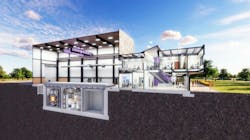Nuclear in the Oil Patch: Natura, Texas Tech Exploring SMR to Power Water Desalination from Shale Drilling
Texas-based small modular nuclear startup Natura Resources is strengthening its project ties across the Lone Star State with new university research partnerships focused on development and future installation of its molten salt reactor (MSR-100) technology.
Natura, which already had announced collaborations with Abilene Christian University (ACU) and Texas A&M, has extended its work to Texas Tech University in Lubbock, near the oil-rich Permian Basin where the company hopes to deploy two future small modular reactor (SMR) nuclear projects.
This collaboration, which includes the Texas Produced Water Consortium (TxPWC) at Texas Tech, focuses on integrating Natura’s MSR-100 technology with water desalination systems. The goal is to provide a sustainable solution for water scarcity by purifying produced water from oil and gas operations, making it available for agricultural and other beneficial uses.
Small modular reactors are seen as a promising carbon-free energy resource for the future, although none have been built or commissioned in the U.S. yet. Natura Resources was one of four SMR nuclear companies which recently signed site deals to develop their reactors near the Texas A&M campus.
"Our collaboration with Texas Tech and ACU is a pivotal step in addressing Texas' critical water and energy challenges,” Natura CEO and founder Doug Robison said in a statement. “By leveraging our MSR technology, we aim to secure crucial water resources and drive innovation in clean energy."
Natura Resources, Kairos Power, Terrestrial Energy and Aalo Atomics were the four SMR startups which recently initiated moves to locate their work at the 2,400-acre Texas A&M—RELLIS campus in Bryan, which is near the College Station main campus.
Nuclear energy generates carbon-free electricity, but is expensive and time consuming to build at a larger conventional level, such as Georgia Power’s Vogtle 3 and 4 expansion which took nearly a decade and cost about $33 billion. SMR proponents believe that their smaller footprints—between 50 to 200 MW as opposed to 1-GW units like Vogtle—and safety innovations will eventually make small nuclear power more of the norm in reactor power generation.
And all of this experimentation and development comes at a time when the U.S. electricity power sector is seeking massive amounts of new capacity to deal with the growth of data centers, artificial intelligence training needs, transportation electrification and reshoring of manufacturing.
“Plain and simple: the United States needs more power,” Texas A&M University Chancellor John Sharp said at the time of the RELLIS announcement. “And nowhere in the country, other than Texas, is anyone willing to step up and build the power plants we need. Thanks to the leadership of Gov. Greg Abbott and others in the Texas state government, Texas A&M System stands ready to step up and do what is necessary for the country to thrive.”
Natura Resources first moved to Abilene and began the process to get approval for its 1-MW molten salt test reactor on the ACU campus. The reactor uses a liquid fuel composed of fissile uranium material dissolved in a molten salt mixture. This design is designed to enhance safety and efficiency and produce less long-lived radioactive waste.
Other oil and gas producers are exploring SMR nuclear to decarbonize operations and ensure steady power in remote shale drilling fields. Diamondback Energy recently signed a non-binding letter of intent to consider a 20-year power purchase agreement with advanced reactor developer Oklo.
SMR nuclear microgrids of the future are a topic of discussion as data center companies and other industrial firms evaluate ways to ensure both energy resiliency and sustainability.
The Microgrid Knowledge Conference will be April 15-17 at the Sheraton Dallas in Texas. Early bird registration is still open until March 6.
About the Author
Rod Walton, Microgrid Knowledge Managing Editor
Managing Editor
For Microgrid Knowledge editorial inquiries, please contact Managing Editor Rod Walton at [email protected].
I’ve spent the last 15 years covering the energy industry as a newspaper and trade journalist. I was an energy writer and business editor at the Tulsa World before moving to business-to-business media at PennWell Publishing, which later became Clarion Events, where I covered the electric power industry. I joined Endeavor Business Media in November 2021 to help launch EnergyTech, one of the company’s newest media brands. I joined Microgrid Knowledge in July 2023.
I earned my Bachelors degree in journalism from the University of Oklahoma. My career stops include the Moore American, Bartlesville Examiner-Enterprise, Wagoner Tribune and Tulsa World, all in Oklahoma . I have been married to Laura for the past 33-plus years and we have four children and one adorable granddaughter. We want the energy transition to make their lives better in the future.
Microgrid Knowledge and EnergyTech are focused on the mission critical and large-scale energy users and their sustainability and resiliency goals. These include the commercial and industrial sectors, as well as the military, universities, data centers and microgrids. The C&I sectors together account for close to 30 percent of greenhouse gas emissions in the U.S.
Many large-scale energy users such as Fortune 500 companies, and mission-critical users such as military bases, universities, healthcare facilities, public safety and data centers, shifting their energy priorities to reach net-zero carbon goals within the coming decades. These include plans for renewable energy power purchase agreements, but also on-site resiliency projects such as microgrids, combined heat and power, rooftop solar, energy storage, digitalization and building efficiency upgrades.

